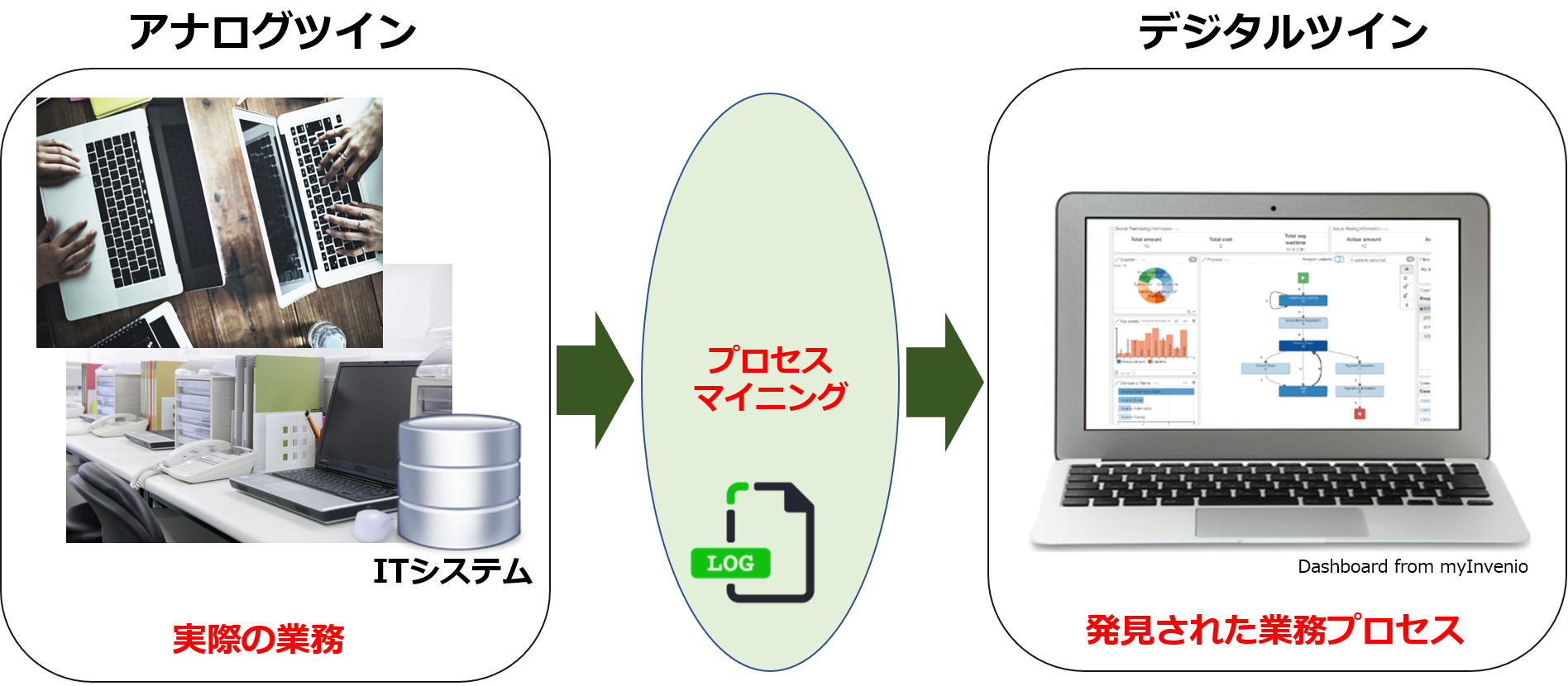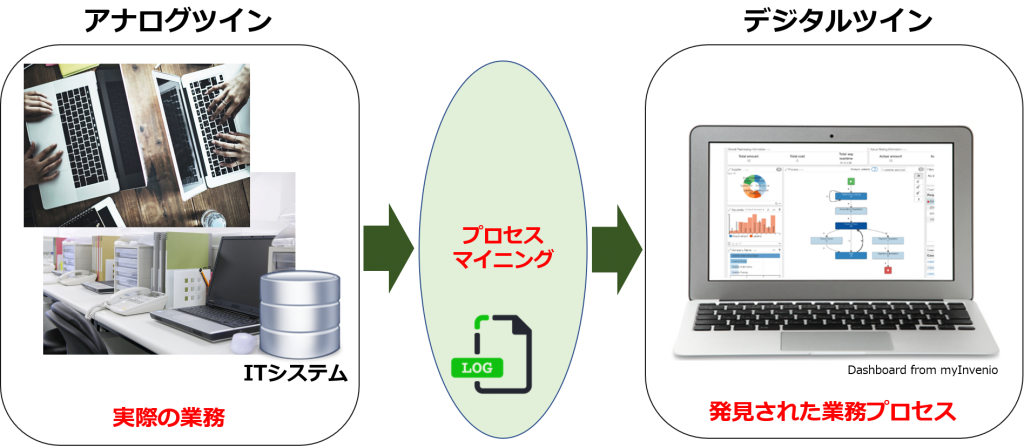Process mining can materialize a digital twin of an organization.
English follows Japanese. Before proofread.
「デジタルツイン」は、純粋なテクノロジーとしてはビジネスに適用範囲が限定されるものではありませんが、プロセスマイニングにおいては、「Digital twin of an organization」の略称です。
「Digital twin of an organization」は直訳すれば、「組織のデジタルな双子(片割れ)」となります。
一方、現実の職場、仕事は「アナログな双子(片割れ)」です。アナログな現場では、多くのスタッフが協働しながら業務を行っています。ただ、業務の多くがITシステムで遂行されるようになったことから業務内容がデジタルな足跡(Digital footprint)として残されています。
デジタルな足跡、すなわち「イベントログ」をプロセスマイニングで分析することにより、今まで見えなかった業務内容を可視化することができるようになりました。業務プロセスの流れはフローチャートとして”発見”できます。
プロセスマイニングによって、案件処理数や、アクティビティ単位の「処理時間(サービスタイム)」や前工程から次工程までの移行時間、すなわち「待ち時間(ウェイティングタイム)」なども算出可能であり、業務負荷の高い箇所、業務が滞留しているボトルネックの特定が容易になりました。
また、誰がどんな業務を担当しているのか、誰と誰が業務を通じて連携し、協働しているのかも明確に把握可能です。
重要な点は、ぼんやりとしかわかっていなかった業務の流れや処理件数、所要時間、協働関係などを事実(fact)に基づいて明確化できることです。プロセスマイニングによって見える化された各種のフローチャートや図表は、まさに、組織の在り方、業務内容をデジタルデータに基づいて再現した「デジタルツイン」だと言えます。
デジタルツインを実現するメリットは、現実をファクトベースで正確に把握できることだけではありません。デジタルツインであれば、一部の工程を削除したり変更したらどうなるか、あるいは一部のプロセスをRPAで自動化したら全体にどのような影響が起こるのか、シミュレーションが行えます。
すなわち、どのように業務プロセスを改善すれば、リードタイム短縮化、コスト削減、ボトルネックは解消できるのかを検証したうえで、アナログツイン、つまり実際の現場、現実のプロセスに展開することが可能です。
さらには、ITシステム上に記録され続けているイベントログをリアルタイムでプロセスマイニングツールに流し込めば、現場の業務遂行状況をデジタルツインにおいて監視し、問題点の即時是正が行えます。
以上でおわかりのように、プロセスマイニングは、デジタルツイン実現のために必要不可欠のツール、ソリューションです。
“Digital twin” is not limited to business as a pure technology, but in process mining, it stands for “Digital twin of an organization”.
The literal translation of “Digital twin of an organization” is “one digital half of twins of an organization “.
On the other hand, the other half is “Analog half of twins of an organization” where employees work together in the analog field. However, since much of the work is now performed by IT systems, the work remains as a digital footprints.
By analyzing digital footprints, or “Event Log” through process mining, it has become possible to visualize previously unseen business operations. The flow of business processes can be “discovered” as a flowchart.
With process mining, we can calculate the number of cases processed, the “Processing time (service time)” per activity, and the transition time from the previous process to the next process, i.e., the “Wait Time (waiting time)”, etc., making it easier to identify areas with high workload and bottlenecks with stagnant business.
In addition, it is possible to clearly understand who is in charge of what kind of work and who is collaborating and collaborating with each other through work.
It is important to be able to clarify, based on the facts, the flow of work, the number of processes, the time required, and the functions involved in collaboration that were only vaguely understood. The flow charts and diagrams visualized by process mining are truly “digital twin” that reproduce the way an organization works and the contents of business operations based on digital data.
The benefits of a digital twin are not just accurate fact-based reality. With a digital twin, you can simulate what happens if you delete or change some of the processes, or if you automate some of the processes with the RPA and see the overall impact.
In other words, after examining how to improve business processes to reduce lead time, reduce costs, and eliminate bottlenecks, it is possible to apply the method to an analog twin, that is, a real process.
In addition, by flowing the event log continuously recorded on the IT system into the process mining tool in real time, the work execution situation in the field can be monitored in the digital twin, and the problem can be corrected immediately.
As you can see, process mining is an essential tool and solution for achieving a digital twin.


